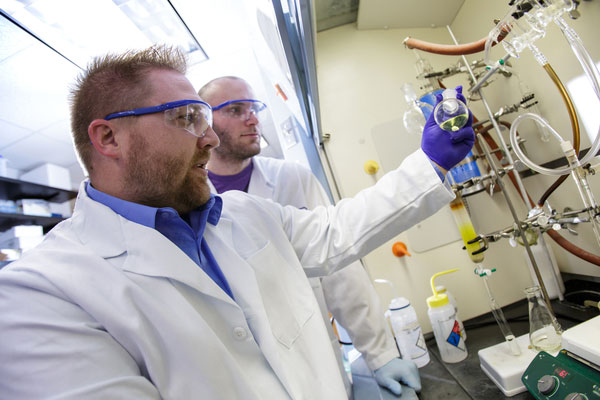Researchers at the University of Florida have developed potent new compounds with aquatic origins that may offer relief for the 17 million Americans affected by biofilm-associated bacterial infections annually.
The series of compounds known as the halogenated phenazines, or HPs, can kill dangerous bacterial biofilms present in recurring and chronic bacterial infections such as methicillin-resistant Staphylococcus aureus, or MRSA. The discovery may one day offer a cure for persistent bacterial infections that are largely resistant to conventional antibiotic treatments.
“Using synthetic chemistry, we have developed a series of marine antibiotic-inspired molecules that target a problem conventional antibiotics are unable to address because cells housed within bacterial biofilms are tolerant of them,” said Robert Huigens, an assistant professor of medicinal chemistry at the UF College of Pharmacy and lead investigator of a study published in the Angewandte Chemie journal’s online edition. “We have been aware that biofilms greatly contribute to infections over the past 20 years, but there are no biofilm-eradicating therapeutic agents available. Discovering and developing potent biofilm-killing agents is the first step toward eradicating biofilms in patients.”
Biofilms are bacterial communities that accumulate and attach to surfaces, including live tissues in humans.
The bacterial cluster is often slow or non-growing, encased in a protective layer of diverse biological molecules that form a ‘slime,’ and displays tolerance to every known class of antibiotic treatments available.
Biofilm infections affect almost every tissue in the body, and without a way to eliminate the biofilm, chronic and sometimes fatal infections develop over time. Common biofilm infections include pneumonia in cystic fibrosis patients, chronic wounds and implant- and catheter-associated infections.
In the study, UF researchers tested in a laboratory the HP compound’s ability to eradicate biofilms of several major human pathogens, including MRSA; methicillin-resistant Staphylococcus epidermidis, or MRSE; and vancomycin-resistant Enterococcus faecium, or VRE. In addition, HP compounds proved to have potent antibacterial activity against the slow-growing pathogen Mycobacterium tuberculosis, or TB. HP compounds not only proved effective in eradication efforts but also selectively targeted the biofilms without breaking down the encasing cell membrane of healthy human cells.
Prior to his study, most compounds that have been able to kill biofilms operate by punching holes in cell membranes, Huigens said.
“Previous biofilm-eradicating compounds have been difficult to develop as they destroy cell membranes of both bacterial cells and healthy human cells,” he said. “Our discovery offers the potential for future drug therapies to selectively target the cells within biofilms without killing human cell types. This discovery could lead to a major breakthrough in biomedical research.”
The HP compounds developed by UF researchers originated in a marine environment. At the College of Pharmacy’s Center for Natural Products, Drug Discovery and Development, scientists are exploring the untapped biodiversity of the world’s oceans to aid in drug discovery and therapeutic treatments.
“In the center, we identify natural products with promising biomedical utility and oftentimes use them as a starting point to create compounds that are even more powerful or selective than what nature provides us,” said Hendrik Luesch, a professor and chair of the Uppercase Department of Medicinal Chemistry at the College of Pharmacy and the Debbie and Sylvia DeSantis chair in natural products drug discovery and development.
“This research is a prime example where the marine environment provided a template that upon further chemical modification resulted in excellent biofilm-eradicating agents. Through our expanding screening platform in the center, we were able to discover anti-tuberculosis activity for certain HP compounds, which opens up additional opportunities for drug development.”
A collaborative effort that included researchers from UF’s departments of medicinal chemistry, molecular genetics and microbiology, and epidemiology helped to learn more about the special biofilm-eradicating compounds that are also effective against TB. The team plans to continue synthesizing and developing the new compounds originating from the world’s oceans in pursuit of drug therapies that will finally offer a cure for persistent bacterial infections.

